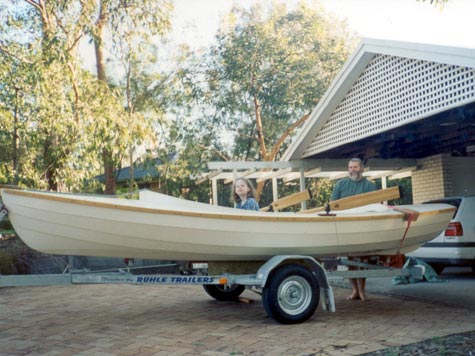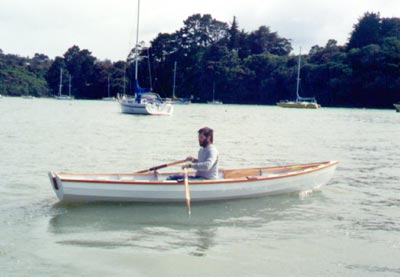Some Thoughts on Rowing
I love rowing, unlike most of my friends who consider that it’s a chore that has to be done only when the outboard motor refuses to start. But the very same people are often keen hikers or ride mountain or touring bikes or go to the Gym and pay others to supervise their self torture. Strange people.
It took a while to realise that what they disliked, and what I so enjoy are very different. Now hows that I hear you say, a pair of oars, a boat and some water, whats so different?
Their boats ( and that’s usually a kind overstatement for a horrid, poorly maintained little barge) are different, the oars are different, and the water is theoretically the same but the boat uses it differently.
In order to be comfortable rowing a good fit is needed. The boat, its seat, footrests and oars should fit at least as well as those fancy shoes that the sports shoe clinic with its video screen and treadmill sell you. Its not so easy to do that, but heres some ideas.
I like fixed seat boats, and they are the simple ones that suit open water as well as those flat calms that early morning and late evenings see. So its those boats like Joansa, the Light Dory and Walkabout that I’m talking about here.

Wayne Jorgensen and his Walkabout
Fixed seats, that seat should be about 6 or 8inches above your heels when ready to row. With your footrest in the right position that means that much of your weight will be taken on the large muscles under your thighs rather than those pointy bones in your pelvis so you can be a lot more comfortable. At that height the angle between shin and thigh, thigh and back is comfortable, the long muscles at about medium extension when under load, and nothing will be strained or overstretched leading to sore spots.
Your footrest, especially in a boat that will be used in rough water, and that’s not necessarily very rough either, needs to have your feet at least a foot apart. The conventional footrest with the feet right side by side comes from a competition boat that is so narrow that a skinny rowers behind overhangs both sides and we need the bracing effect more than that racer does.
The other benefit here is that when really pulling hard (c’mon Fred, he’s catching up!!!!) the knees can flex apart when bending the torso forward to take a long stroke which eases the stress on the lower back.
Rowlocks. Apart from the technical aspects of them, the positioning is critical. Make them more than 3ft 10 in apart minimum. This is because the narrower spacing causes the wrist to be flexed though too much of an angle when the oar is swung through a long stroke. If you hold your hands out with the forearms parallel with your desktop and hands holding an imaginary oar handle in each then push your hands away from you, then back to your sides you will notice that the hands "axis" or angle changes as though it is following the oar in its pivot. The natural radius of that pivot for most medium sized people gives a rowlock spacing of about 4ft 4in which is wider than most fixed seat small boats, 4 ft works well but, as I said, not less than 3ft 10in or the wrists get sore.
Those rowlocks should be about 8in above your seat in a light boat, but can be as much as 11 in above if the boat is large and heavy. You will note that the Whaleboats and Pilot Gigs of which you see pics in glossy magazines are rowed with hands right up at chest height to give more leverage but this is a difficult style to get used to and not really relevant to our sort of use.

My own Joansa
A rowlock is positioned in two axes, height being one, and the other is the distance aft of the rower. I set mine up with the pivot point about 13inches aft of the after edge of my seat. That puts my upper arms vertical with my back straight and the oars dead straight across. Don’t bring them any closer than that, but you could put them an inch or so further away if that feels right.
Rowlocks should have NO slop. They should turn freely and smoothly, and I go to the trouble of fitting self lubricating plastic bushes held into hardwood mountings with bronze plates. Its worth putting in some time here as otherwise they wear very quickly and a sloppy shaft makes them pretty awful to use.
The oars, balance is very important. I have mine so that the tip just sits in the water with the full weight of my hand and forearm on the handle, if its balanced right the action of the return stroke pushes the oar clear of the water without having to actually lift it. The first time you use a pair set up like this they will feel odd, but I can guarantee that after a few minutes anything else will feel like a pair of two by four planks with lead weights on the ends.
Balancing them is not easy, it requires a lot of material to be removed from the blades, ¼ in thick is plenty for the blade edges and a rib should be left down the middle. I leave that ridge as a point sticking out from the end of the blade, it looks cute and gives me something to push the boat off with without damaging the thinned down blade.
I also use the old fashioned plumbers sheet lead as a counterweight, about 1/8in thick and in this case about 4in wide around the shaft right in by the handle. Don’t overdo it from a balance point of view and do paint it to protect yourself, lead is poisonous.

Seagull
Oar shafts ( we are talking about commercially made oars here) are heavy parallel lumpish things, and don’t recognise that as a lever, they need to be strong at the pivot end and can be light where they enter the blade. You can plane that end down to about 1 ¾ in x 1 1/8 in with the longer dimention at right angles to the blade and take that dimension gradually tapering back up to the leather where the rowlock is.
Blade shape, you will note in your pics of historic working craft that they seldom used wide blades, in fact the Faroese and Shetlanders, the West Coast Irish, and the Cornishmen, all famous open water rowers in their various boats used very narrow blades and thole pins which allowed no feathering of the oar.
So I use a narrow blade, about 3 ¼ inches only, on my own boats the blades are fairly long at 32 inches but narrow and no I don’t feather them either. A rowing cruise which may take me several days at 6 hours or so a day would leave my forearms in rigidly cramped agony if I had to feather the oars every stroke. I used to feather nicely when I thought that someone was watching, but don’t even bother with that any more.
Buttons. That bulge or rest on the oar which stops it from sliding out through the rowlock, I don’t use ‘em. What I do though is put a lanyard around the neck of the oar down by the blade, up around the rowlock shaft and back about 18in to a lightweight tent rope adjuster. If it blows up I need to row with more oar inboard to change to a lower gear so just slide it in and take pup the slack on the tent rope adjuster ( the gear ratio is the ratio between the oar inboard and outboard of the rowlock, more inboard is for going upwind and more outboard for downwind. Just like your ten speed , or in my case I think my bike has about 21 speeds but you get the picture).
Anyway, I digress. Leathers, I use heavy split chrome leather shiny side out, contact glued to the shaft and herringbone stitched along the seam. The seam is handed, up and aft where the least contact with the rowlock is and the leather should be at least 14 inches long centered about halfway relative to the rowlock.

Wayne Chittenden in his Light Dory
I have tried all shapes of oar handles and dont like any of the fancy ones. I use straight and parallel ones ( runs out and measures them) 37mm diameter and 145mm long, I set the oar up at the right pitch and see where my thumb fits under the grip and sandpaper a little flat there so the second joint of my thumb fits comfortably against the flat when the oar is at the right pitch .
I have damaged my right hand a bit ( cut tendons on little and next fingers, they are all hooked back up but not as strong as they were ) so have customised that grip a bit to suit but otherwise dont like barrel shapes, tapers a la Pete Culler or oval shaped grips.
Seat, the coccyx is not only an odd thing to find the correct spelling for, its very very painful if damaged. And a poor seat can rub the skin off your tailbone after a day or three at the oars, so I have taken the soft closed cell foam from an old lifejacket and cut the area where the tailbone is away completely, and glued to the foam a covering of natural sheepskin from an old rug . Note to those who don’t live in New Zealand or Australia, a sheepskin rug is one of life’s real luxuries. Come and visit New Zealand and take one home with you, if you don’t do anything else while you are here just that will make it worth the trip.
Boats, preferably long, light and fairly slim. They can be simple, you can build them yourself and there are lots of different kinds to pick from. Each type has its fans, but each type is suited to a slightly different use and environment. Ask an informed designer for suggestions and be prepared to answer a few questions. Again, it need not be complex, and in my opinion the considerable benefits for the modest investment of time and money are considerable.
There is a lot to this rowing thing, but unlike most sports you can do it all yourself. Fixed seat recreational rowing has not attracted the high profile fakers and big money that many other sports have, its not had to get it right, and you can enjoy the feeling of your body working perfectly in harmony with a machine that takes you to paradisical places . Has to be good for both body and soul.
John Welsford,
Designer

